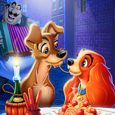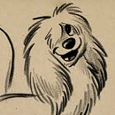Walt Disney Productions (June 22 1955), Walt Disney Home Entertainment (February 7 2012), Blu-ray plus DVD, 76 mins plus supplements, 1080p high-definition 2.55:1 original CinemaScope ratio, DTS-HD 7.1 Master Audio, Rated G, Retail: $39.99
Storyboard:
Walt Disney’s delightful tale of a pampered pooch who meets a dog from the wrong side of the tracks returns to home video, looking better than ever in a beautiful, top pedigree restored transfer!
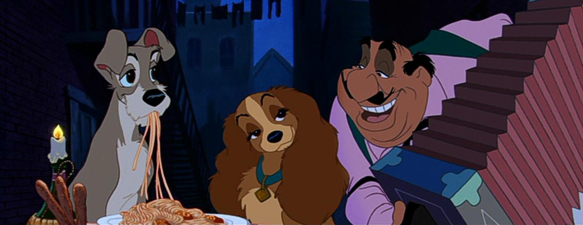
The Sweatbox Review:
Although the rise of Mickey Mouse and the introduction of Disney’s stable of characters and the first animated feature length film often contributes to the marking out of the 1930s as animation’s Golden Age, the 1950s – and in particular the year of 1955 – could arguably be labelled the Studio’s most prolific. With a return to full-length feature cartoons after the break of World War II, Disney Studios saw the release of Cinderella, Alice In Wonderland and Peter Pan within the first three years of the decade, and added to this was Walt’s move into television, spearheaded by a Wonderland Christmas special, followed by The Mickey Mouse Club and his weekly anthology series.
Disneyland mixed both original content such as the Davy Crockett phenomenon and flat-out promotional material, often peeking behind the scenes of Disney’s animated and live-action films of the time, which included his first true live-action film Treasure Island (1950) and the epic adventure 20,000 Leagues Under The Sea, also of 1955. It was often here that the Disneyland provided both a publicity outlet for Walt and an as-yet unheard of raising of the curtain that allowed viewers a sneak peek at coming attractions and how they were ostensibly created. Disneyland, or course, was also a way for Walt to fund another Disney project, the theme park itself – all of which seemed to come together in the same year that Marty McFly time traveled to in Back To The Future…1955.
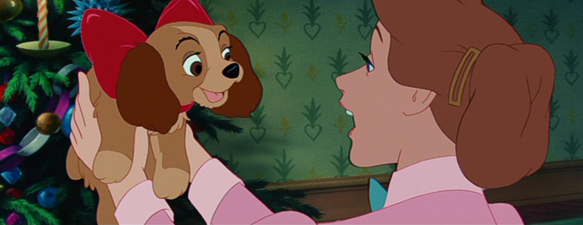
This same year saw the summer release of Lady And The Tramp, the Studio’s first officially self-penned story since 1941’s Dumbo and one that was especially close to Walt due to its turn of the century American small town setting that evoked his home town of Marceline (also reflected in the park’s Main Street entrance). Set in 1910 just as Christmas draws close, the film finds Jim Dear (voiced by television regular Lee Millar) presenting his wife with a hatbox, from which the adorable pup Lady (actress Barbara Luddy) pops up, and Jim’s wife Darling (singer Peggy Lee) is smitten.
Lady soon has the run of the house, making good friends with neighbours Jock (long time Disney voice Bill Thompson) and Trusty (Bill Baucom, later of many other television outings). When the stork drops off another present for Jim and Darling, Lady must take second place to a new baby, something she has trouble accepting, especially when Aunt Sarah (another Disney regular, Verna Felton) arrives to help out and takes an instant dislike to having a pooch around. Into Lady’s life comes Tramp (Larry Roberts), a mongrel from quite literally the wrong side of the tracks, whose devil may care and streetwise attitude excites Lady who, much to Jock and Trusty’s chagrin, runs off with him after a particularly nasty moment with Aunt Sarah’s cats Si and Am (Lee again).
Out in the free, Lady and Tramp draw closer together during the course of their adventures, which see a dangerous scrap with some other street dogs, a comical aside with a rather confused beaver (animation voice and comedy legend Stan Freberg) and, of course, the most famous romantic image not only in all of Disney, but one that has made a significant contribution to the entire film world – Lady and Tramp’s candlelit dinner at Tony’s restaurant, where an accordion, an Italian ballade, spaghetti and meatballs create the perfect romantic movie moment.
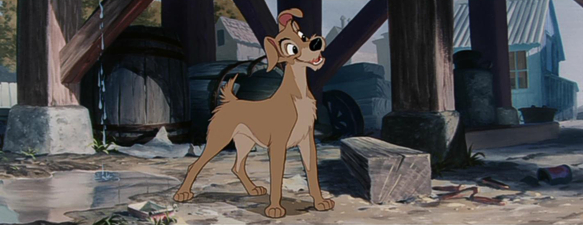
But idyllic bliss can not remain forever, and Lady is soon caught and sent to the pound, where she finds out what a dog Tramp truly is from his old friends (Disneyland recording artists The Mello Men) including one-time companion Peg (Lee again, singing the film’s breakout song, He’s A Tramp). When Lady’s registered collar lets her off the leash and Tramp turns up at her home again, she understandably attempts to drive him off her turf, but Tramp has seen lurking danger in the form of an evil looking rat who seems intent on causing the Dears’ baby distress. The exciting climax sees Tramp, Jock and Trusty in a race against time that could save the baby, but might also set a certain path to doom for Tramp…
It’s certainly a departure from the usual kind of Disney fare that had come before, possibly much to do with the rather melodramatic dramas of the time, churned out by directors such as Douglas Sirk and the like. Lady And The Tramp’s origins have been steeped in rumor over the years, with perhaps the most publicity-friendly being the story that Walt once presented his wife Lily with a pup in a hat box the way Lady is brought into the Dears’ lives. Although the story has always been taken with a pinch of salt, the supplements here delve deeper, revealing the actual impetus for the film, its journey through re-writes and Studio-sponsored book form, and finally into a screenplay that became one of Walt’s most admired, and adult, animated films.
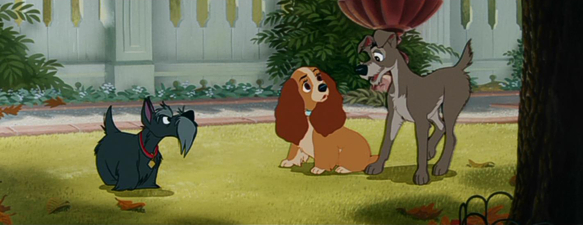
Yes, adult. By this I mean the mature tone of the film, the fact that is has been exceptionally realized from the view of our characters’ canine eye level, and that it is at heart a true love story, filled with the kind of mischief and comedy that one would expect from Disney, but brought down a notch or two to really let the story and the characters’ emotions shine through. The writing is superb, inviting a genuine real-world mentality into the script and how the characters’ lines are delivered. Although this is a dog’s story, it’s a story that hasn’t gone to the dogs, being a very well observed and basically human story about as close to “kitchen sink drama” as one could attempt to describe a Disney confection.
Likewise the animation is up to scratch, being among the most delicately handled of all Disney’s features, coming after the knockabout and adventurous fantasies of Alice and Peter Pan, respectively, and just before the ambitious Sleeping Beauty, perhaps the zenith of the Disney-styled fairytale picture. Walt’s Nine Old Men certainly pulled out all the stops in their cartooning of the canine stars and though one never forgets one is watching a cartoon, the whole look smacks of authenticity both in the designs and the deep, lushly painted backgrounds. The editing is also less frantic than we may be used to in animation, due in part to the story, and also in helping the wider frame – the first time Disney expanded into widescreen – sustain interest where constant cross cutting would feel clumsy and too erratic.
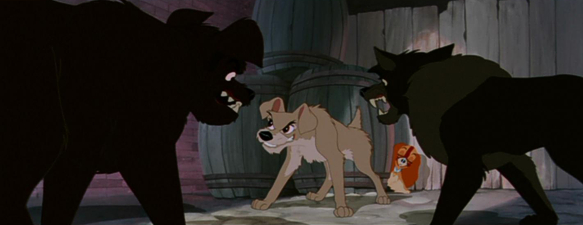
These wider vistas also give the animators room to breathe – more than once you’ll notice that the camera often stays fixed and it is the characters’ movements that keep things ticking along, just as in a live action setting. Perhaps this calmer atmosphere was a reaction to Alice In Wonderland, which had garnered much criticising of its haphazard zaniness, and the fact that the story was fresh and new (based in part on Ward Greene’s Happy Dan The Whistling Dog And Miss Patsy The Beautiful Spaniel, written directly for the Studio) allowed more scope without being bogged down by preconceptions from famous books.
There is certainly a less rambunctious air about Lady And The Tramp than in other Disney films, and the usual fantasy world of animals conversing with humans is shied away from, with each species only speaking to and being understood by their own kind, a concept I can’t recall being repeated to any extent until the much more recent Brother Bear. There’s also the obvious love story aspect about it all, too, featuring one of the Studio’s most realistically depicted relationships – canines or not! As Tony the cook mentions to Tramp during the film’s signature Bella Notte number, “You settle down with this-a one, eh?”, referring to Tramp’s reputation.

For another thing (and as Feature Animation producer Don Hahn points out in the extras), the Studio artfully but respectfully conveyed the fact that young lovers do mate – and this yet even before “marriage” and in the confines of conservative American 1950s moviemaking, an often overlooked touch when one thinks of Disney as being just for kids. Which brings us to the much relied-on-for-suspense theme of death in the movie: Tramp, of course, lives in fear of the dog catchers, despite being a scallywag and lovable “dog about town”, while Peg and the boys in the pound have obviously led dubious lives in the past and do not face much future. Apart from their moment to shine, built around Peg’s He’s A Tramp sequence, the dogs appear solely for the reason to fill Lady in on Tramp’s womanising life, and to set up the third-act’s “ticking clock” danger.
But they add so much more, again bringing to the fore the unspoken but fairly obvious fact that these pooches won’t probably last out the week – something instantly made aware to adults as flea-ridden Nutzy is led away “through the one-way door”. Kids more than not will be oblivious to this – they’ll seem to think that the pound is a pretty fun place and that the Mello Men sing there still. Peg herself seems to be something of a pooped-out showdog, someone who has been there and done it all, and imparts her words of advice about Tramp to Lady as a take-it-or-leave-it weary conquest, as her melancholy song plays out. Perhaps the only moment that doesn’t ring quite true is paradoxically one of the film’s most remembered, the Siamese Cat Song, as sung by Peggy Lee in the dual roles of Aunt Sarah’s felines Si and Am. Into this fairly straight dramatic story come these two mischievous moggies who upset not only Lady’s life, but also to an extent the balance of the movie.

Theirs is the only truly kid-friendly segment – often repeated on Disney clip shows – which brings a sense of comedy to the picture. The artists have fun with the gags, and the lyrics are full of clever wordplay, but to be honest the sequence never quite fit for me. The cats come and go too quickly – we really neither care where they came from nor what happens to them. If they had been a bigger part of Lady’s life – perhaps as a continuing interference – then they would have registered more in their role in getting Lady in to trouble. So, despite their comic asides and a rather excellent song, I have never been able to see them for much more than being the weakest, most extraneous moment in Lady And The Tramp, something that the similar comic Beaver sequence just manages to avoid in overcoming an important plot point.
To pick on these aspects too much is to miss the point however. Lady And The Tramp is not only one of Walt’s most sophisticated films – on many levels – it is also one of filmmaking’s masterpieces, sadly overlooked more often than not in the general consensus even if it does score highly on “romantic movie” lists. It’s full of inventive ways of storytelling (Lady’s growing “overnight” to show the passing of time, the visual shorthand use of shadows and the rainstorm during the film’s most suspenseful sequences), which may feel somewhat clichéd nowadays, but was thrilling at the time – the silhouette of the rat against a lightning bolt towards the end surely still drives up the peril factor and excites.
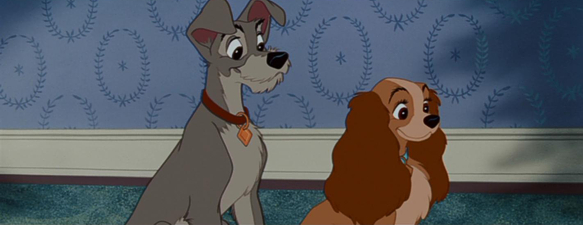
Some critics have taken the overt realism of the film to task, but for me there’s nothing like telling a story like this in animation. The medium serves up the kind of clean world we can only remember in memories, while how else would anyone get its cast to act accordingly in scene after scene other than by the current, but increasingly tired, vogue of computer animation augmentation, something that could scream of over excessive visual effects vulgarity in attempting a subtle story such as this by comparison. Lady And The Tramp on reflection then, and as this superbly restored high-definition showing reveals, is a much more intricate and rewarding film than one might be expecting or indeed remember from growing up. It could only have ever been told in animation, and by the team of animators and voice cast members here. In a funny way, I always pictured Tramp as a Dean Jones type, and even though the film came before the actor’s association with the Studio and he never voiced an animated creation at Disney’s, there’s more than a hint of Dean in Tramp’s design and vocal reading.
Likewise Lady And The Tramp is an important milestone in the Disney canon as it marked an end to the fairytale formula and introduced variety into animated features. The use of Peggy Lee could also arguably be the first time a superstar celebrity voice was used in a cartoon film – Disney had often used radio personalities (the most famous of which were probably Edgar Bergen and Robert Benchley), but Lee was a bona fide recording star well in her own right when Walt persuaded her to join the cast. Some more esteemed critics than myself have levelled claims against the “static cartooning”, or the overly “sterile look” in the past, but surely that’s part of the film’s charm in recreating a world recognisable as our own, but different enough to place the characters in their own land. Either way, Lady And The Tramp is pure gold Disney, and as close a tribute to man’s best friend as any could hope for.
Is This Thing Loaded?
The latest upgrade in the Diamond Edition line, Lady And The Tramp puts the series back on track with the Platinum DVDs of old after The Lion King replaced Cinderella’s spot last fall. That classic is set to get the Diamond treatment towards the end of this year and it will be interesting to see if it can beat the surprisingly light treatment it got on DVD, something the original Lady And The Tramp set only just about managed to surmount itself. For the most part, this new edition is more than just a Blu-ray upgrade, although there’s none of the truly immersive extras, or sheer wealth of them, that some might have been hoping for, with very little “new” that hasn’t been seen on the DVD.
A BD and DVD Combo pack, the discs predictably kick off with a series of Sneak Peeks, some of which run automatically and some of which are menu-based. Among the previews here are the spot for Disney’s online All Access concept, the upcoming Diamond Cinderella, Pixar’s Brave, Beverly Hill Chihuahua 3, Disney Movie Rewards, ABC’s The Chew, Mary Poppins on stage, Disney Channel’s Shake Up, Disneynature’s Chimpanzee, Tinker Bell’s Secret Of The Wings, a welcome HD debut for The AristoCats and another “Special Edition” release, this time in HD, for the adequate DTV sequel Lady And The Tramp II: Scamp’s Adventure, which looks only to add a little to its two previous DVD attempts.

As with the original Platinum DVD, I’d love to be able to announce the inclusion of an entire second version of Lady And The Tramp as a bonus – the film in its original Academy format release. Made just as cinema screens became wider to compete with television, Lady And The Tramp was the first animated feature created for the CinemaScope widescreen format. Walt was well aware that many theaters had not completed the conversion process to widescreen, and that his in-roads into television were already seeing classics such as Dumbo being readied for their television broadcasts. So, just as Pixar issued additional “full-screen” versions of their widescreen films for now redundant 4:3 home video viewing in the 1990s, two versions were composed on the animation camera stands: the “official” 2.55:1 CinemaScope edition, and a second, almost just as official 1.33:1 Academy, or TV-shaped, version.
This was not just a cropped version of the movie, but an entirely alternatively framed edition, just as valid for its intended use. It was a major bugbear of mine that Disney of today, in their wise choice, decided not to include this edition in the DVD release, choosing instead to offer a totally pointless pan and scan transfer, and I have to say that despite the much more prevalent wider displays we have now I’m still disappointed that they haven’t included it again here, providing a unique comparison and truly authentic reason for including two versions of the film in the set. A previously restored print of the Academy version does exist, having popped up on LaserDisc format in the 1990s, but I guess space must have been an issue here: nonetheless, at least we are not bothered by the terrible cropped version that is thankfully a no-show here.
An Introduction (1:20) and retrospective piece with Walt’s daughter, Diane Disney-Miller: Remembering Dad (7:50) looks back on the highly productive years that led up to the release of Lady And The Tramp in 1955 and the opening of Disneyland, specifically focusing on Walt’s legendary firehouse apartment at the park. Here, Diane gives us a tour of that space and relates stories behind many of the trinkets and items that fill it (it’s fun to know I share Walt’s love of grilled cheese sandwiches!), and the way the Disney family would use and entertain at the apartment. Although not tied directly to the movie, it’s reflective of the time of its release, and the closest one is likely to get to a peek inside even if parts of it have been recreated at the Family Museum in San Francisco. As an extra, there’s a chance to experience a 360-degree look at the apartment via the Disney Second Screen option, which brings us to…

Accompanying the movie in its theatrical widescreen framing is another delve Inside Walt’s Story Meetings, intended to be presented in concert with the latest Second Screen addition. I’ve made my thoughts on the Second Screen concept, and the eventual inevitability of that online content being removed, clear before but here it frustrates on a whole new level because here, whereas a Cine-Explore experience would have featured additional concept and developmental images right on the screen as an added picture-in-picture presentation, you have to now watch a second screen to appreciate all that extra stuff.
Yes, it’s great content, and the interactivity can be cool, but when we pay for a full-featured Blu-ray Disc in a prestigious series, we expect to get that kind of – let’s face it – very basic content on the actual disc where we can return to it at leisure and without having to power/hold/sync up another device. For all of Blu-ray’s higher features, we seem to have seen very little that utilizes them! Without Second Screen in play, viewers can still enjoy its Audio Commentary element, which reproduces the transcripts of Walt and his crew obviously interestingly, but apart from optional on-screen photo captions for each speaker, it’s just such a shame concept art isn’t also offered for illustration.
Since Lady And The Tramp is a scant hour and a quarter, and the majority of supplements are in standard definition only, there’s no need for another disc: everything is right here on a single platter, under the Bonus Features menu option. Providing some incentive for those with the previous Platinum set are three supposedly newly unearthed Deleted Scenes ( in a Play All configuration), the first of which sets up the character of Boris, one of two dogs vying for Lady’s affections in the early 1940s version of the film. Very different to the eventual movie, this is just lovely to see, especially in how teeny bits of character business were kept in through the changes, even if Boris quickly becomes tiresome to endure.

A further brief elaboration on Jim Dear’s anticipation of the baby’s birth and a lengthy diversion into a performing dog show, which could have either provided a highlight sequence or unbalance the film entirely, make up the almost 20 minutes of generous material, presented in reconstructed storyboards. Also to be found is the Never Recorded Song I’m Free As The Breeze (1:26), a singing moment for Tramp from a 1940s take on the story that would have probably been inserted at the moment we first meet him at the railroad tracks or as he describes his carefree life to Lady, although the new recording here is attached to various story sketches that don’t suggest any real continuity. Nevertheless, it’s a jaunty little number that was cut when it was decided that Tramp shouldn’t be a musical character – something he ultimately shares with most of the rest of the cast since none of the leads have any such moments.
If we run through the list of remaining supplements “backwards”, there are more Deleted Scenes to be found in the Classic DVD Bonus Features from the Platinum set, with a Play All option running them for a near-thirteen minutes. Eric Goldberg serves as an unofficial host for these extras, popping up here with an Introduction to the scenes, which include Turning The Tables (an overlong, but whimsical abandoned concept that saw the dogs keeping their human owners as pets in a very literal sense) and The Arrival Of Baby (an alternative concept that slightly extends the Dears’ expecting plans leading into a longer La-La-Lu song sequence). Happily acknowledging that viewers must now have some inkling of what a storyboard is, Goldberg skips the “it’s like a comic strip panel of the movie” talk and gets right to specifics; both scenes are bookended by footage that shows where they would have feature in the movie, and the newly recorded voice actors’ (uncredited here) recreations sound almost spot on in their respective roles.
Moving back into the disc’s chronological listing and bringing most of the meatballs to this particular table is the seven-part documentary Lady’s Pedigree: The Making Of Lady And The Tramp, which runs over 52 minutes if selected as a Play All option. The piece runs though Walt’s early years in Marceline, Missouri, and its inspiration for Lady And The Tramp’s setting, the development of the story, its path through animation, scoring, voice recording, and the film’s artistic style. It’s a very nice documentary, as authoritatively put together one on any Disney LaserDisc or DVD release, and there’s a great amount of archival footage of both Walt returning home and of the film’s production.
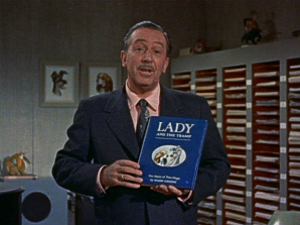
But while one might hope that interviews with the original animators might have been conducted before their passing (even Ollie Johnston, the last remaining of Walt’s original Nine Old Men briefly seen here, is now no longer with us), that is not the case and instead we hear about how the new crop of Disney artists have responded to the film over the years. Two television specials are plundered for behind the scenes material, and while this leads to much repetition a nice touch is that both of these are excerpted at length elsewhere here, so it’s not a case of one or the other. Extensive use of production photographs add to the retrospective feel, while best of all is Frank Thomas’ home movie footage taken to explore the movements of the family dog. Less satisfactory is the fact that the full-frame Academy edition of the film (see below) is referenced and discussed, without that version being made available for comparison.
Finding Lady: The Art Of Storyboards is a look at this much shown and historically important development by Walt Disney and its place in the film process. This is a good overview of the form’s backstory, but it doesn’t really have anything to tie it specifically to Lady And The Tramp apart from brief mentions which, really, could have come from any Disney feature (there’s actually more focus on Beauty And The Beast). From Goldberg, we hear how Walt used storyboards to keep everybody involved in production on the same page and how the process was picked up by others (most notably Hitchcock), while the filmmakers of today are dubiously represented by Kevin Costner in director mode, who explains via clips from the (Disney) movie Open Range how he set up his shots and found boarding sequences to be a worthy tool.
While none of this has anything to do with the main movie (and I did wonder if Costner’s footage had not been culled from some Range press kit material), he does pay direct tribute to Walt, so this could have been shot specifically for this featurette. Studio “synergy” rears its head by having director Andrew Adamson chime in with similar comments, though he’s obviously here more to slip in some references to the then-fresh first Narnia movie rather than to impart any real info. As a history of storyboarding, this 13 minute piece does its job well, however familiar we are with this method of pre-production (yes, “storyboards are like a comic strip”), and informs with the minimum of fuss. Continuing the theme is a collection of Original 1943 Storyboards for a much earlier, but actually more contemporary feeling, version of the story with Eric Goldberg and long-time Studio story artist and director Burny Mattinson.

The pair have the original boards pinned up and walk through the scenes as they would if they were pitching the film to their colleagues. While this is very fun (Tramp’s name skipped between Homer and Bozo at this time, while the Siamese Cats were Nip and Tuck), and a most welcome inclusion, what about if they had recreated the entire film and recorded dialogue to reconstruct a full alternate version – how cool would that have been? We’ve seen similar feature-length storyboard presentations in the past (on the Studio Ghibli discs and even the Work In Progress of Beauty And The Beast), and such an elaborate supplement could have made up for the lack of Cine-Explore on the Story Meetings option. Still, this 12-minute piece does what it does in a very cute fashion, with music and spot sound effects livening up the delivery, and it’s always fun to see Goldberg and Mattinson’s enthusiasm.
On the Platinum set, Goldberg also introduced a fascinating section on the creation of The Siamese Cat Song, in which we were able to peek at early storyboard concepts and hear demo recordings that illustrated how the song (originally intended to be performed by two male singers) was developed. None of that is included here, except for The Siamese Cat Song: Finding A Voice For The Cats, a 1:50 clip that compiles several different demos without any kind of context. I suppose we should be thankful for its inclusion, since some of the voices here could still be misconstrued as being rather stereotypical in any day and age, but without the additional material it has been left as something of an orphaned clip that doesn’t really make sense.
DisneyPedia: Going To The Dogs (also on the DVD) looks back over the history and types of dogs, with Disney clips mixed in with current real world pooches and their owners. Hosted by comic actor Fred Willard, a very funny man who has commentated on canines very amusingly before in Christopher Guest’s mockumentary (or should that be dogumentary?) feature Best In Show, the clip runs 9:20, while also offered is the fairly pointless Bella Notte music video, not by Peggy Lee, but by singer Steve Tyrell, who coincidentally had a Disney album out about the time the Platinum set hit stores. It’s a pretty par-for-the-course clip, running 2:55 and mixing live-band studio footage with animation from the film, though to be honest, and while the slow jazz version of the song is pretty smooth, I found Steve quite scary!
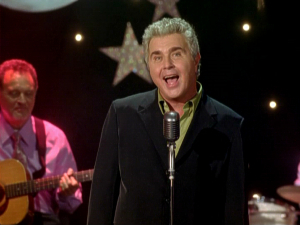
A trio of Theatrical Trailers begin an exploration into the film’s publicity – again pulled from the DVD and disappointingly not in HD. The 1955 original runs 3:50, presented in letterboxed CinemaScope 4:3, and is typical of the leisurely paced previews of the time, introducing us to all the characters in a somewhat overly melodramatic way, with more than a little touch of pathos. A very brief forty-five second spot from the 1972 re-issue is presented in Academy full-frame. 1980s Disney re-issue trailers are always a lot of fun and a 1986 one doesn’t disappoint as it does it’s best to try and make Lady And The Tramp an excitingly adventurous kids movie – something it really didn’t need any help doing! The 1:30 trailer (“first time in Dolby Stereo”) is enjoyable nonetheless, and is presented in an “open matte” Academy version which would have been masked in theaters.
Moving on to save the really cool stuff for last, and we come to Excerpts From Disneyland TV Shows – now THIS is why supplemental feature fans have got to love Walt Disney. He was making behind the scenes extras – albeit of the rather cheesily staged kind in this day and age – over 50 years ago – talk about looking ahead! The two shows lengthily excerpted here are A Story Of Dogs (from December 1954) and Cavalcade Of Songs (from the February of 1955). As usual, we don’t get the entire, fully uncut versions of these shows, but A Story Of Dogs may be familiar to those with The Complete Pluto set in the Walt Disney Treasures line, since the parts relating to Mickey’s pooch in that show were presented in those bonuses. But what we get here is very cool stuff – probably my most favorite extras in the set and the most likely to be revisited.
And, making the selection even better is that fact that the sequences shown here have been reconstructed from original color negatives that have been matched up to the final, black and white master cut of the show. In a four-minute introduction, Goldberg explains that as a result the image quality may vary throughout the programs, but I didn’t notice any unexpected or truly distracting anomalies and seeing this footage in color far outweighs any technical inconsistencies. First up is A Story Of Dogs, which originally took the viewer through Disney’s canine history with Pluto and then went on to introduce the stars of his latest, upcoming feature Lady And The Tramp. The 17:30 running section is simply charming, with many of the original crew on hand to explain their role in the making of the picture, including a potted storyboard version of the story, the work of the layout boys, pencil test footage, original recordings sessions and footage of the legendary Frank Thomas and Milt Kahl in action, animating their scenes!

Simply put – what more could anyone ask for? Something on the movie’s songs? Well, Walt has you covered there too, which dovetails nicely into Cavalcade Of Songs, the second excerpted show. This program also originally contained more footage, namely a look back at some of the highlights in Disney’s song catalog, which was pretty vast even then, but the sections retained here, running 21:40, concentrate solely on the songwriting process for Lady And The Tramp, with a great deal of time spent with singer/songwriter Peggy Lee and co-songwriter Sonny Burke. The footage of Lee singing He’s A Tramp is scintillating, while the Mello Men in the studio performing Home Sweet Home is downright hysterical. All the pieces to camera in both shows are very staged, having been “reconstructed” for television, but their very nature and the information conveyed is amazingly acute.
A further bonus is a three minute black and white preview from a previous show that tees up the A Story Of Dogs program, but best of all is that all the clips from the finished Lady And The Tramp movie shown in these native full-frame shows are indeed from the correct, television-sized 1.33:1 Academy print – be sure to inspect the alternate framing of the menacing dogs and Tony’s serenade to Lady and Tramp among other highlights, to compare the differences between the widescreen Academy versions in the event of the no-show here.
WHAT’S MISSING?
As always with Disney’s Platinum and Diamond Edition releases, supplements fall through the cracks, for one reason or another, from previous releases. Lady And The Tramp’s first real collector’s edition was a deluxe LaserDisc edition, although this featured nothing of major significance that hasn’t been included here. The Academy ratio version of the movie also made an appearance on LaserDisc and it now seems that release is the only way to see Walt’s approved alternate framing.
A Limited Issue DVD didn’t add anything to its platter, but the Platinum DVD offered up a few extra elements missing from this new upgrade. Most disappointingly not carried over are a selection of Lady And The Tramp Galleries, collating a series of some 300+ images charting the Visual Development, Character Design, Storyboards, Layouts And Backgrounds, and behind the scenes Production Photos (and offering the opportunity to add some publicity and poster stills).
Despite some of them being made available via the Second Screen option, it would have been much better to have those images here too – and in HD please – for close up inspection or as part of an enhanced Story Meetings presentation. Eric Goldberg’s missing exploration of The Siamese Cat Song has been touched on above, but again there’s no real excuse for those elements being absent here either, especially when this leaves the remaining included clip without much sense or context.
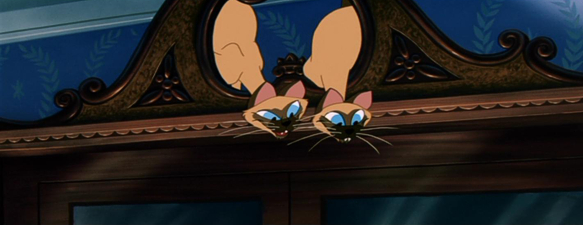
Less essentially not pulled across is a personality profile, but the virtual board game Disney Dog Trivia did offer up a great deal of fun. Finally, the Adopt A Virtual Puppy DVD-ROM bonus has been clearly superseded by what the likes of the Nintendo DS can do now, but surely Blu-ray’s capabilities might have been used to update this so that younger viewers could look after their own caricatured editions of the Lady And The Tramp characters?
Overall this is a nice package, but perhaps predictably and obviously there’s nothing on Lee’s public sprat with the Studio over the rights to her vocal performance which, at the time of her signing, did not include home video reproduction rights. She was awarded $3.83 million in 1991, after a lengthy court case that opened the gates for other artists to re-negotiate their contracts, most famously the wife of The Jungle Book’s King Louie, Lois Prima, which remains a political Disney Studio hot potato even to this day.
Case Study:
Despite minor switches in designs across the Diamond Edition line (blue borders, grey borders, silver, etc…), things have pretty much remained consistent as opposed to the Platinum discs that seemed to change from each title to each title (double width keepcases, single width slipcovered releases, some that folded out or were embossed, others that were not, selected titles in gift boxes, etc…), so here we get the usual slimline BD case and a Diamond-grey tinted, blue bordered, embossed slipcover to match previous releases.
It’s otherwise business as usual too, with the Bella Notte sequence getting the front sleeve promotion (in fact, I think it’s the exact same Platinum cover image) as with almost every release before it, and a BD Guide inside that maps out the extras. Most exciting is a booklet promoting upcoming HD titles, including a couple of personal favorites due to come to disc in a The Rescuers: 2-Movie Collection. A separately sold edition, which bundles in a Digital Copy disc for a few dollars more, features the same artwork except for a gold-bordered front.
Ink And Paint:
As if the stunning clean up by Lowry Digital Images wasn’t enough for the DVD, Disney seems to have returned to Lady And The Tramp to offer an even more pristine visual experience in HD, again preserving the full CinemaScope aperture of the 2:55:1 frame as opposed to being slightly cropped to 2.35:1 as in the past. Needing less extensive digital scrubbing than the earlier classics to begin with, due to both its age and photographic process, there’s really not much to be said for how the film looks other than to repeat the old phrase about it looking the best it ever has and more than likely superior to how even 1955 audiences saw it.

Print debris (or anything that marked the likely negative used as a source) and cel scuffing has been removed – something that may or may not please puritans – as is in line with other Disney restorations, allowing us to essentially see the film had it been assembled with the technology of today. The DVD looks predictably softer, and more so than usual, but that could be because the HD spoils us. Top marks!
Scratch Tracks:
As well as being Disney’s first widescreen presentation, Lady And The Tramp also scored a first for being the Studio’s first truly surround track in the modern sense of the term, so the team behind the Disney Home Theater mix on the original Platinum release had a good place from which to start in creating a contemporary, and somewhat warmer, soundfield for that DVD. It’s that same mix that’s basically offered again as the default here, albeit now encoded in DTS Master Audio format. And it sounds pretty good for a near 60 year old soundtrack, with a nice spread and limited but fun surround activity stemming from the original’s multi-track mixing.
For the purists, an original theatrical soundtrack is also included (also in DTS-MA), and this time it’s the real deal, instead of the 2.0 stereo mix that was featured on the Platinum DVD. Basic left and right channels accompanied the film in the old-style Academy ratio theaters, but it was a true surround track – or at least the 3.0 equivalent of the time – that featured with CinemaScope engagements. It’s nice to hear it again after being previously encoded for the LaserDisc edition, but the new 7.1 re-mix is just as well-crafted, and as such is probably the sound to go for; there is certainly nothing objectionable or gimmicky about it. Original French and Spanish dubs are also included.
Final Cut:
Improving slightly on the Platinum set it replaces, the switch to two releases per year in that line and the dip in supplemental quality (or the sheer wealth of it) can still be felt in this reissue, which doesn’t add enough new elements to be more than perhaps the most undernourished Diamond Edition yet. The inclusion of the Academy version may have been for completists only in this widescreen world, but it would have added more value for those collectors, but at least the totally redundant cropped transfer doesn’t make any kind of appearance. The limited new extras don’t add much of a bonus, and from what has been pulled over, the music video and games all feel a bit lightweight and lean the set slightly towards the kid-market as opposed to the Blu-ray collector.
However, on the flipside, it’s once again the excellent film that wins all the points here and surely that’s the reason for a purchase in the first place. Kudos does go to the teams responsible for the supplemental documentary features which, however slight and repetitive of the same archive footage several times throughout, and relying on the second hand testaments of current animators, do their best to create a satisfying look behind the scenes. As a Blu-ray experience, it’s not as involving as a Snow White or Beauty And The Beast, but make no mistake – this is still a hearty recommendation for its smattering of welcome archive television segments in particular and, of course, the wonderfully presented movie.
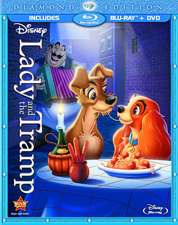 | ||
 |


